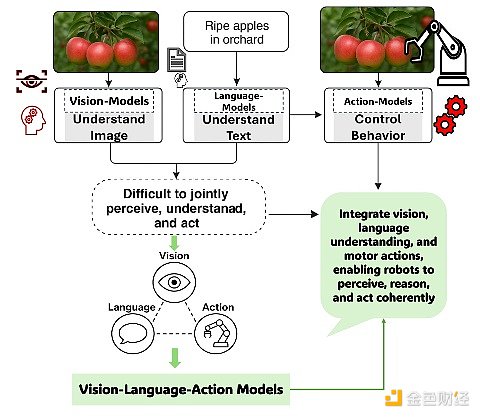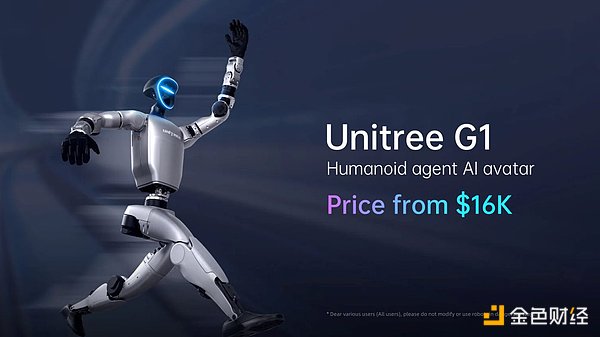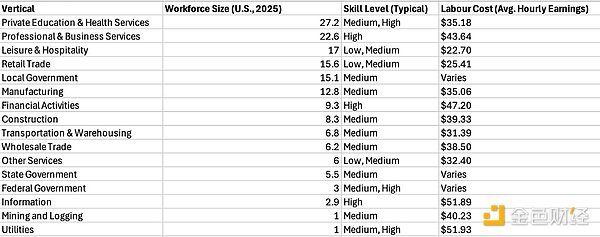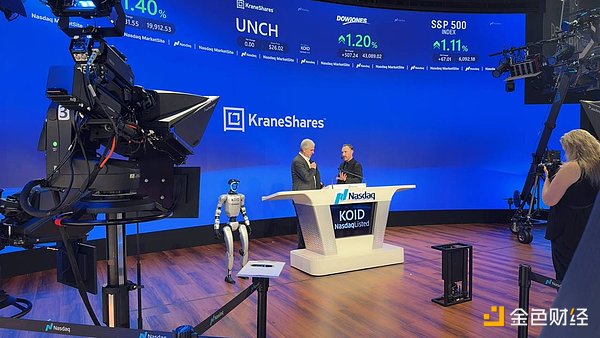Author: Paul Veradittakit, Partner at Pantera Capital; Translator: Jinse Finance xiaozou
Abstract:
VLAInnovation and scale are driving the birth of affordable, efficient and universal humanoid robots.
As warehouse robots expand into the consumer robot market, robot safety, financing and evaluation mechanisms deserve further exploration.
Crypto technology will drive the development of the robotics industry by providing economic guarantees for robot safety and optimizing its docking infrastructure, latency and data collection processes.
ChatGPT completely rewrites human expectations of artificial intelligence. When large language models began to interact with the external software world, many people thought that AI agents were the ultimate form. But if you look back at classic science fiction movies such as "Star Wars", "Blade Runner" or "RoboCop", you will find that what humans really dream of is that artificial intelligence can interact with the physical world in the form of robots.
In Pantera Capital's view, the "ChatGPT moment" in the field of robotics is coming. We will first analyze how breakthroughs in artificial intelligence have changed the industry landscape in the past few years, and then explore how battery technology, latency optimization and data collection improvements will shape the future landscape, and the role of encryption technology in this. Finally, we will explain why we believe that robot safety, financing, evaluation and education are the vertical areas that need to be focused on.
1、Change Factors
(1)Artificial Intelligence Breakthrough
Advances in the field of multimodal large language models are giving robots the "brains" they need to perform complex tasks. Robots mainly perceive the environment through two senses: vision and hearing.
Traditional computer vision models (such as convolutional neural networks) are good at object detection or classification tasks, but they have difficulty converting visual information into purposeful action instructions. Although large language models perform well in text understanding and generation, they are limited by their ability to perceive the physical world. 
Through the Vision-Language-Action model (VLA), robots are able to integrate visual perception, language understanding, and physical actions in a unified computing framework. In February 2025, Figure AI released Helix, a universal humanoid robot control model. This VLA model sets a new benchmark for the industry with its zero-shot generalization capability and System 1/System 2 dual architecture. The zero-shot generalization feature allows robots to instantly adapt to new scenes, new objects, and new instructions without repeated training for each task. The System 1/System 2 architecture separates high-order reasoning from lightweight reasoning, realizing a commercial humanoid robot with both human-like thinking and real-time accuracy.
(2)Affordable robots become a reality
Technologies that change the world all have one thing in common – accessibility. Smartphones, personal computers, and 3D printing technologies have all become accessible through prices that are affordable to the middle class. When robots like the Unitree G1 cost less than a Honda Accord sedan or the minimum annual income of $34,000 in the United States, it is not surprising to imagine a world where manual labor and daily tasks are mainly performed by robots.

(3)From warehousing to consumer markets
Robotics are expanding from warehousing solutions to the consumer sector. The world is designed for humans - humans can do all the work of professional robots, but professional robots cannot do all the work of humans. Robot companies are no longer limited to manufacturing factory-specific robots, but are developing more general-purpose humanoid robots. Therefore, the forefront of robotics technology is not only in warehouses, but will also penetrate daily life.
Cost is one of the main bottlenecks for scalability. The metric we are most concerned about is the comprehensive cost per hour, which is calculated as the sum of the opportunity cost of training and charging time, the cost of task execution and the cost of robot acquisition, divided by the total operating time of the robot. This cost must be lower than the average wage level of the relevant industry to be competitive.

To fully penetrate the warehousing field, the comprehensive cost of robots per hour must be less than $31.39. In the largest consumer market, private education and health services, the cost must be kept below $35.18. Robots are currently developing in the direction of becoming cheaper, more efficient and more versatile. 2. The next breakthrough in robotics (1) Battery optimization Battery technology has always been a bottleneck for user-friendly robots. Early electric vehicles such as the BMW i3 were difficult to popularize due to the limitations of battery technology, resulting in short battery life, high cost and low practicality. Robots are facing the same dilemma. Boston Dynamics' Spot robot has a single battery life of only 90 minutes, and the Unitree G1 battery has a battery life of about 2 hours. Users are obviously unwilling to manually charge every two hours, so autonomous charging and docking with infrastructure have become the key development direction. Currently, there are two main modes for robot charging: battery replacement or direct charging.
Battery swap mode enables continuous operation by quickly replacing depleted battery packs, minimizing downtime, and is suitable for field or factory scenarios. This process can be done manually or automatically.
Inductive charging uses wireless power supply. Although it takes a long time to fully charge, it can easily achieve a fully automated process.
(2) Latency optimization
Low-latency operations can be divided into two categories: environmental perception and remote control. Perception refers to the robot's spatial cognition of the environment, while remote control specifically refers to real-time control by human operators.
According to Cintrini research, robot perception systems start with cheap sensors, but the technical moat lies in the integration of software, low-power computing and millisecond-level precision control loops. When the robot completes spatial positioning, lightweight neural networks will mark obstacles, pallets or humans. After the scene labels are entered into the planning system, motor commands sent to the feet, wheels or robotic arms are immediately generated. Perception latency below 50 milliseconds is equivalent to human reflex speed - any latency above this threshold will cause the robot to move clumsily. Therefore, 90% of decisions need to be made locally through a single vision-language-action network. Fully autonomous robots need to ensure that the latency of high-performance VLA models is less than 50 milliseconds; remote-controlled robots require that the signal latency between the operator and the robot does not exceed 50 milliseconds. The importance of VLA models is particularly prominent here - if visual and text inputs are processed by different models and then input into a large language model, the overall latency will far exceed the 50 millisecond threshold. (3) Data collection optimization There are three main ways to collect data: real-world video data, synthetic data, and remote-controlled data. The core bottleneck of real data and synthetic data is to bridge the gap between the robot's physical behavior and video/simulation models. Real video data lacks physical details such as force feedback, joint motion errors and material deformation; simulation data lacks unpredictable variables such as sensor failure and friction coefficient.
The most promising data collection method is remote control - a human operator remotely controls the robot to perform tasks. However, labor costs are the main constraint for remote control data collection.
Customized hardware development is also providing new solutions for high-quality data collection. Mecka combines mainstream methods with customized hardware to collect multi-dimensional human motion data, which is processed and converted into a data set suitable for robot neural network training, and provides massive high-quality data for AI robot training with a fast iteration cycle. These technical pipelines together shorten the conversion path from raw data to deployable robots.
3Key Exploration Areas
(1) Integration of Encryption Technology and Robots
Encryption technology can incentivize trustless parties to improve the efficiency of robot networks. Based on the key areas mentioned above, we believe that cryptography can improve efficiency in three aspects: connecting infrastructure, latency optimization, and data collection.
Decentralized Physical Infrastructure Network (DePIN) is expected to revolutionize charging infrastructure. When humanoid robots run globally like cars, charging stations need to be as accessible as gas stations. Centralized networks require huge upfront investments, while DePIN distributes the costs to node operators, allowing charging facilities to expand rapidly to more areas.
DePIN can also optimize remote control latency using distributed infrastructure. By aggregating geographically dispersed edge node computing resources, remote control commands can be processed by local or nearest available nodes, minimizing the data transmission distance and significantly reducing communication latency. However, current DePIN projects mainly focus on decentralized storage, content distribution, and bandwidth sharing. Although some projects demonstrate the application advantages of edge computing in streaming media or the Internet of Things, they have not yet extended to the fields of robotics or remote control.
Remote control is the most promising way to collect data, but it is extremely costly for centralized entities to hire professionals to collect data. DePIN solves this problem by incentivizing third parties to provide remote control data through cryptographic tokens. The Reborn project builds a global network of remote operators, converts their contributions into tokenized digital assets, and forms a decentralized system without permission - participants can not only obtain benefits, but also participate in governance and help AGI robot training.
(2) Safety is always a core concern
The ultimate goal of robotics is to achieve full autonomy, but as the "Terminator" series of movies warns, humans are most reluctant to see autonomy turn robots into offensive weapons. The security issues of large language models have attracted attention, and when these models have physical action capabilities, robot safety becomes a key prerequisite for social acceptance.
Economic security is one of the pillars of the prosperity of the robot ecosystem. OpenMind, a company in this field, is building FABRIC, a decentralized machine coordination layer that realizes device identity authentication, physical presence verification and resource acquisition through cryptographic proof. Unlike simple task market management, FABRIC enables robots to independently prove identity information, geographic location and behavior records without relying on centralized intermediaries.
Behavior constraints and identity authentication are enforced on-chain, ensuring compliance can be audited by anyone. Robots that meet safety standards, quality requirements, and regional regulations will be rewarded, while violators will face penalties or disqualification, thus establishing accountability and trust mechanisms in autonomous machine networks.
Third-party re-staking networks (such as Symbiotic) can also provide peer-to-peer security guarantees. Although the penalty parameter system still needs to be improved, the relevant technology has entered the practical stage. We expect that industry safety guidelines will be formed soon, and the penalty parameters will be modeled based on these guidelines.
Implementation example:
Robotics company joins the Symbioticnetwork.
Set verifiable slashing parameters (e.g., "applying a human contact force exceeding 2500 Newtons");
The staker provides a deposit to ensure the robot complies with the parameters;
If a violation occurs, the deposit will be used as compensation for the victim.
This model both incentivizes companies to put security first and promotes consumer acceptance through the insurance mechanism of the pledge pool.
The Symbiotic team's insight into the field of robotics is:
Symbiotic's universal pledge framework aims to extend the concept of pledge to all areas that require economic security endorsement, whether through shared or independent models. Its application scenarios range from insurance to robotics technology and require specific design for specific cases. For example, a robot network can be built entirely on the Symbiotic framework, allowing stakeholders to provide financial guarantees for the integrity of the network. 4. Fill the gaps in the robot technology stack OpenAI has promoted the popularization of AI, but the foundation of the ChatGPT moment has long been laid. Cloud services have broken the model's dependence on local computing power, Huggingface has made the model open source, and Kaggle has provided an experimental platform for AI engineers. These incremental breakthroughs have jointly contributed to the popularization of AI. Unlike AI, the field of robotics is difficult to get started when funds are limited. To achieve the popularization of robots, the development threshold needs to be lowered to the same level of convenience as AI application development. We believe that there is room for improvement in three aspects: financing mechanism, evaluation system and education ecology. Financing is a pain point in the field of robotics. Developing a computer program only requires a computer and cloud computing resources, while building a fully functional robot requires purchasing hardware such as motors, sensors, and batteries, which can easily cost more than $100,000. This hardware attribute makes robot development less flexible and more expensive than AI.
The evaluation infrastructure for real-world robot scenarios is still in its infancy. The AI field has established a clear loss function system, and testing can be fully virtualized. But excellent virtual strategies cannot be directly translated into effective solutions in the real world. Robots need evaluation facilities to test autonomous strategies in diverse real-world environments to achieve iterative optimization.
When these infrastructures mature, talent will pour in, and humanoid robots will repeat the explosion curve of Web2. Crypto robotics company OpenMind is moving in this direction - its open source project OM1 ("Android for robots") transforms raw hardware into an economically aware, upgradeable intelligent agent. Vision, language, and motion planning modules can be plug-and-play like mobile phone apps, and all reasoning steps are presented in plain English, allowing operators to audit or adjust behavior without touching the firmware. This natural language reasoning capability allows a new generation of talent to seamlessly enter the field of robotics, taking a key step towards an open platform that will ignite the robotics revolution, just as the open source movement has accelerated AI.

Talent density determines the trajectory of the industry. A structured inclusive education system is crucial for the delivery of talent in the field of robotics. OpenMind's listing on Nasdaq marks the beginning of a new era in which intelligent machines participate in both financial innovation and physical education. OpenMind andRobostore jointly announced that they will launch the first general education curriculum based onUnitree G1 humanoid robots in K-12 public schools in the United States. The course design is platform-independent and can be adapted to various robot forms, providing students with practical operation opportunities. This positive signal strengthens our judgment: In the next few years, the richness of robotics education resources will be on par with the field of AI.
5. Future Outlook
The innovation and economies of scale of the Vision-Language-Action model (VLA) have spawned affordable, efficient and versatile humanoid robots. As warehouse robots expand into the consumer market, security, financing models and evaluation systems become key exploration directions. We firmly believe that encryption technology will promote the development of robots through three paths: providing economic guarantees for safety, optimizing charging infrastructure, and improving latency performance and data collection pipelines.
 Anais
Anais







